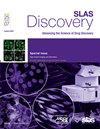Enhancing throughput and robustness of the fibroblast to myofibroblast transition assay
IF 2.7
4区 生物学
Q2 BIOCHEMICAL RESEARCH METHODS
引用次数: 0
Abstract
Idiopathic pulmonary fibrosis (IPF) is a chronic and progressive age-related lung disease with an average survival of 3–5 years post-diagnosis if left untreated. It is characterized by lung fibrosis, inflammation, and destruction of lung architecture, leading to worsening respiratory symptoms and physiological impairment, ultimately culminating in progressive respiratory failure. The development of novel therapeutics for the treatment of IPF represents a significant unmet medical need. Fibroblast to myofibroblast transition (FMT) in response to fibrogenic mediators such as transforming growth factor beta 1 (TGF-β1) has been identified as a key cellular phenotype driving the formation of myofibroblasts and lung fibrosis in IPF. Establishing a robust and high-throughput in vitro human FMT assay is crucial for uncovering new disease targets and for efficiently screening compounds for the advancement of novel therapeutics aimed at targeting myofibroblast activity. However, creating a robust FMT assay suitable for high-throughput drug screening has proven challenging due to the requisite level of automation.
In this study, we focus on evaluating different automation approaches for liquid exchange and compound dosing in the human FMT assay. A semi-automated assay, capable of screening a large number of compounds that inhibit TGF-β1-induced FMT in both Normal Human Lung Fibroblasts (NHLF) and IPF-patient derived Disease Human Lung Fibroblasts (IPF-DHLF), has been successfully developed and optimized. We demonstrate that the optimized FMT assay using liquid handling automation exhibits great assay reproducibility, shows good assay translation using human lung fibroblasts from normal healthy versus IPF-patients, and demonstrates acceptable human primary donor variability. This allows for the standardization of comparisons of compound anti-fibrotic potency across IPF projects.
增强成纤维细胞向肌成纤维细胞转化试验的通量和稳健性。
特发性肺纤维化(IPF)是一种慢性进行性年龄相关肺部疾病,如果不及时治疗,诊断后平均生存期为3-5年。其特征是肺纤维化、炎症和肺结构破坏,导致呼吸系统症状恶化和生理损害,最终导致进行性呼吸衰竭。治疗IPF的新疗法的发展代表了一个重要的未满足的医疗需求。成纤维细胞向肌成纤维细胞转化(FMT)是对转化生长因子β1 (TGF-β1)等成纤维介质的反应,已被确定为IPF中驱动肌成纤维细胞形成和肺纤维化的关键细胞表型。建立一个强大的、高通量的体外人FMT检测方法对于发现新的疾病靶点和有效筛选化合物以推进针对肌成纤维细胞活性的新疗法至关重要。然而,由于必要的自动化水平,创建一个适用于高通量药物筛选的强大的FMT分析已被证明具有挑战性。在这项研究中,我们着重于评估人类FMT测定中液体交换和化合物给药的不同自动化方法。成功开发并优化了一种半自动化检测方法,能够筛选大量抑制正常人肺成纤维细胞(NHLF)和ipf患者来源的疾病人肺成纤维细胞(IPF-DHLF)中TGF-β1诱导的FMT的化合物。我们证明,使用液体处理自动化的优化FMT分析具有很高的分析重复性,在正常健康的人肺成纤维细胞与ipf患者之间显示了良好的分析翻译,并且显示了可接受的人类原发供体可变性。这允许在IPF项目中比较化合物抗纤维化效力的标准化。
本文章由计算机程序翻译,如有差异,请以英文原文为准。
求助全文
约1分钟内获得全文
求助全文
来源期刊

SLAS Discovery
Chemistry-Analytical Chemistry
CiteScore
7.00
自引率
3.20%
发文量
58
审稿时长
39 days
期刊介绍:
Advancing Life Sciences R&D: SLAS Discovery reports how scientists develop and utilize novel technologies and/or approaches to provide and characterize chemical and biological tools to understand and treat human disease.
SLAS Discovery is a peer-reviewed journal that publishes scientific reports that enable and improve target validation, evaluate current drug discovery technologies, provide novel research tools, and incorporate research approaches that enhance depth of knowledge and drug discovery success.
SLAS Discovery emphasizes scientific and technical advances in target identification/validation (including chemical probes, RNA silencing, gene editing technologies); biomarker discovery; assay development; virtual, medium- or high-throughput screening (biochemical and biological, biophysical, phenotypic, toxicological, ADME); lead generation/optimization; chemical biology; and informatics (data analysis, image analysis, statistics, bio- and chemo-informatics). Review articles on target biology, new paradigms in drug discovery and advances in drug discovery technologies.
SLAS Discovery is of particular interest to those involved in analytical chemistry, applied microbiology, automation, biochemistry, bioengineering, biomedical optics, biotechnology, bioinformatics, cell biology, DNA science and technology, genetics, information technology, medicinal chemistry, molecular biology, natural products chemistry, organic chemistry, pharmacology, spectroscopy, and toxicology.
SLAS Discovery is a member of the Committee on Publication Ethics (COPE) and was published previously (1996-2016) as the Journal of Biomolecular Screening (JBS).
 求助内容:
求助内容: 应助结果提醒方式:
应助结果提醒方式:


